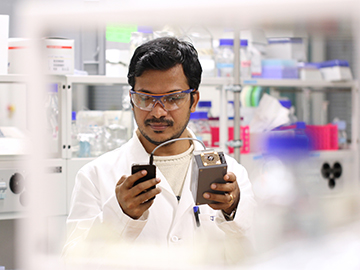
Researcher J.J. Vallooran measures the intensity of the birefringence signal of a test sample with a light meter and an app on his smartphone. Credit: Laboratory Prof. R. Mezzenga / ETH Zurich
Researchers from Switzerland report an affordable, portable platform that uses birefringence to provide real-time diagnoses of diseases and infections (Adv. Funct. Mater., doi: 10.1002/adfm.201503428). Led by ETH Zurich’s Raffaele Mezzenga, the researchers say their birefringence platform, which they estimate would cost CHF 20, can identify an Ebola or HIV infection in less than an hour.
The platform consists of a biosensor in a light-emitting handheld box. The biosensor is based on lipidic cubic phases, which are optically transparent lyotropic liquid crystals (LCs) with confined water nanochannels between lipid bilayers.
To test their platform, the researchers combined a solution containing a cubic phase and an analyte-specific enzyme with a test sample. They placed the combined solution on the light-emitting platform in the box with a filter that polarizes light. Next, they covered the sample with a second, perpendicular polarization filter. If a test sample contained the analyte—i.e., a positive diagnosis—it would react with the enzyme and form crystals in the confined nanochannels. These crystals would create a birefringence signal as light exited the cross-polarized filter setup. If the sample did not contain the analyte, crystals would not form and there would be no birefringence signal. The researchers were also able to calculate pathogen density in the sample by measuring the birefringence signal intensity of the positive test samples with a light meter plugged into a smartphone.
The ETH researchers believe their handheld birefringence box could be particularly useful in areas where expensive or bulky laboratory equipment is not available. “Other than a refrigerator to store the antibodies and enzymes, the user needs only the box to detect the polarized light … This is very inexpensive,” says J.J. Vallooran, first author on the paper.
In addition to Ebola, HIV and other viruses, they say that their diagnostic platform can also detect malaria parasites, E. coli bacteria and biomarkers like glucose and cholesterol in the blood.
